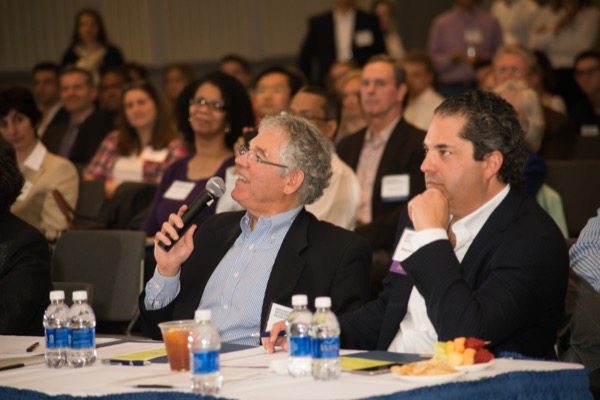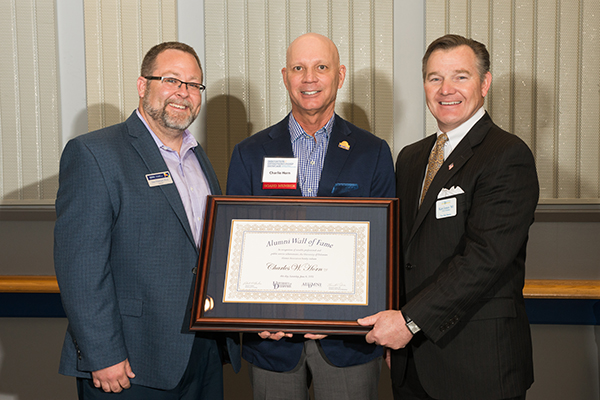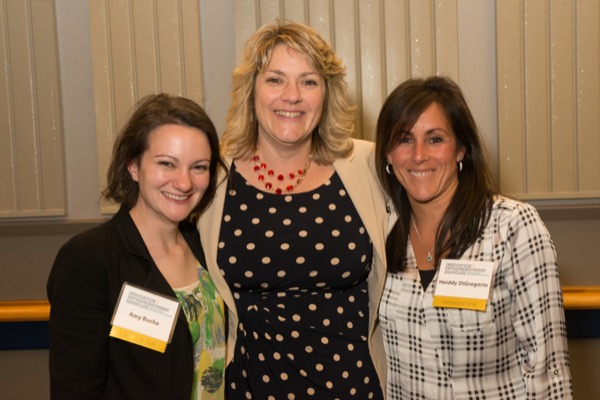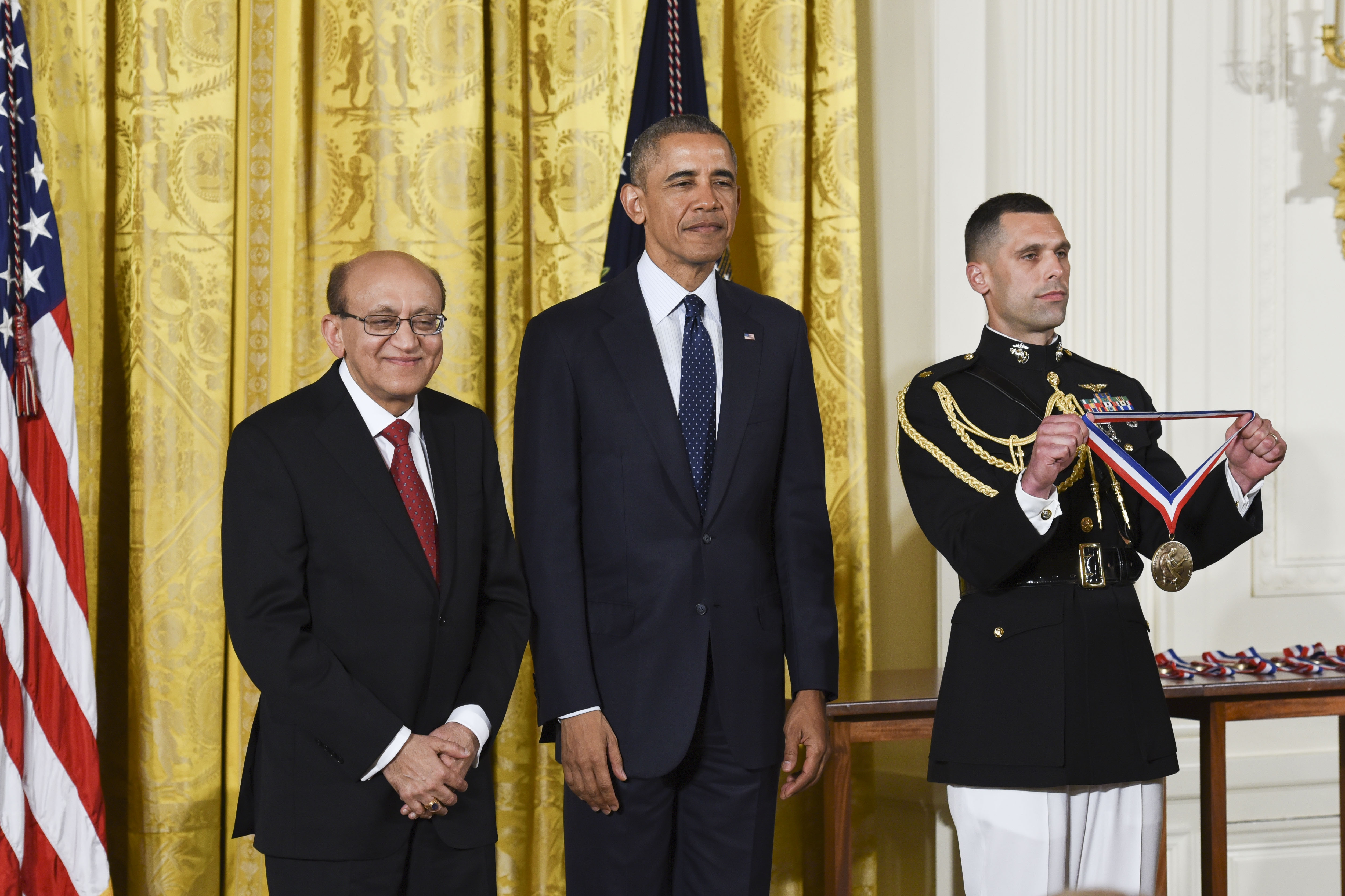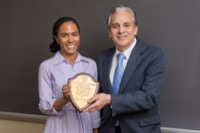

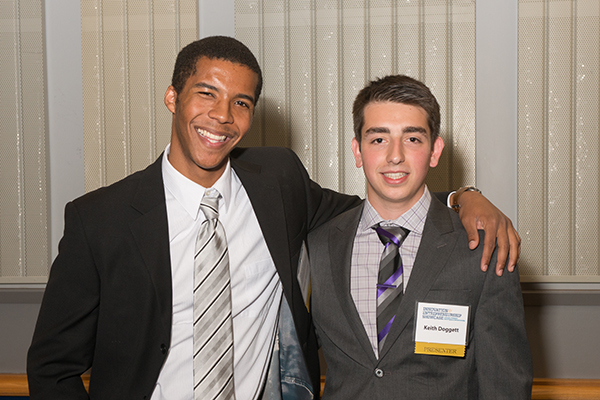
Hatching innovation
UD community members present new business ideas, take home prizes
3:15 p.m., May 5, 2015--Wearable technology that allows nurses to perform surgical simulations on live actors won $8,000 in funding last week as one of the winning ideas at Hen Hatch, the University of Delaware’s premier business startup funding competition.
SimUCare, led by UD nursing faculty members Amy Cowperthwait and Heiddy DiGregorio and alumni Amy Bucha and Robert Tilly, has created six products which, when worn by actors, allow simulated surgeries to be performed on them.
Honors Stories
National Medal of Science
Warren Award
Cowperthwait explained that SimUCare products provide an excellent alternative to the current gold standard in health simulation – synthetic models of human bodies, which “can’t provide feedback from the patient’s perspective.”
“What our products do is combine the best of both worlds,” Cowperthwait said. “We have the human factor, as well as the ability to perform invasive procedures using wearable technology.”
“The student is learning on a person to explain the procedure, to see their responses, rather than on a lifeless mannequin,” she continued. “When they make mistakes, they’re not making them on a real patient.”
SimUCare’s products include SimUTrach, worn by an actor over the chest and throat to allow nursing students to perform tracheostomies, and SimUCath, which enables simulated catheterizations.
“How do you want your health care provider trained?” Cowperthwait asked the audience and panel of judges. “I know I don’t want to be the nurse’s first try.”
Cowperthwait said that the team’s Hen Hatch winnings will be used for field-testing in local simulation centers. The team also received in-kind services from Belfint, Lyons and Shuman and Hunter Public Relations.
“It’s great to win the prize, but it’s also great to see the students learning and benefiting from that experience,” said Cowperthwait. “It’s really about the synergy between the theatre students, the nursing students and the engineering students, all of them working together for one common cause.”
Another winning Hen Hatch team, The Practice Set, received $6,000 for their startup as well as in-kind services from Belfint, Lyons and Shuman.
UD student Jordan Gonzalez, who leads the team with fellow student Keith Doggett, said that the idea for The Practice Set came to him after an exhaustive, five-hour long study session of differential equations did not improve his comprehension.
“I didn’t do very well on the exam, but we did stumble upon a problem: You shouldn’t have to work that hard for absolutely zero return,” Gonzalez said.
Gonzalez and Doggett said that this is a particularly serious issue for science, technology, engineering and mathematics (STEM) students, 48 percent of whom drop out or change to a non-STEM major.
“Our solution is simple,” Doggett said. “We’re going to give the students the practice they need.”
The Practice Set does this by providing relevant practice problems with step-by-step solutions that teach students how to translate the abstract theories they learn in class into the skills to solve real problems. The team said that their winnings will go towards creating more of this content for their website.
“This is amazing,” Gonzalez said. “Just to get the validation that other people agree with this idea just as much as we do really helps us a lot.”
UD students Benjamin Rapkin and Austin Crouse took home $3,250 as well as a $1,000 Audience’s Choice award for their business, ProjectedU. They were also awarded in-kind services from Young, Conaway, Stargatt and Taylor and Hunter Public Relations.
Rapkin and Crouse have created a hardware and software program that uses overhead projectors to share messages with college students in the minutes between classes.
“We’re here to create a culture of engagement within universities,” Rapkin said. “We want college students to recognize opportunities that are available to them and be motivated to take advantage of those opportunities.”
“In order for that to happen, the information has to be presented to them in a way that they want to receive it,” he said.
Some UD classrooms are already utilizing the ProjectedU system, and the team is working with other universities to install the system there.
Another student team, GoHappy, won $3,250 and in-kind services from Young, Conaway, Stargatt and Taylor.
The GoHappy team, led by UD graduate student Elpiniki Apostolaki-Iosifidou, created an application that provides real-time notifications of offers, specials and deals of local businesses.
Apostolaki-Iosifidou said that GoHappy distinguishes itself from similar apps because it allows business owners to submit deals within minutes for real-time updates. It also tracks customers by individual block instead of by the large area of a ZIP code.
The team hopes that their app will benefit customers, businesses and investors alike, “so that everyone GoesHappy.”
UD alumnus Shaun Savage also created an application, GoShare, which won $2,750 at the Hen Hatch finals.
GoShare connects people who have a pickup truck, van or SUV with people who need help moving, hauling, towing, shipping and delivering goods.
The company already has 51 drivers working for them in cities like San Diego, California, as well as a number of customers.
Alumna Emily MacDonald-Korth’s Art Preservation Index, which classifies the longevity and quality of fine art, won $1,750 at the competition.
“Many works of art purchased for millions of dollars will deteriorate in only a few years,” MacDonald-Korth said. “Investors buy these blue-chip works of art assuming the investment is stable, but unfortunately they’re wrong.”
MacDonald-Korth said that her index provides a gauge to measure the stability of art investments, creating more informed consumers.
The panel of judges for the final round of the Hen Hatch competition included:
- Tanya Bakalov, co-founder and senior vice president of operations, SevOne
- Wayne Kimmel, managing partner, SeventySix Capital
- Jeff Davison, general partner, Leading Edge Ventures
- Kris Vaddi, group vice president, Incyte Corp.
- Dawn Willey, founder and chairwoman, Bridgeforce and CMC
Showcasing innovation
This year’s Hen Hatch competition was part of the Horn Program’s inaugural Innovation and Entrepreneurship Showcase.
The showcase also featured a panel discussion on intellectual property, an exhibition of innovative projects from UD’s National Science Foundation I-Corps Sites and First Step Grand Challenges programs, an award ceremony and a networking reception.
Panelists for the intellectual property discussion included:
- Phil Johnson, senior vice president of intellectual property and strategy, Johnson and Johnson
- Vytas Kiselius, CEO, Collection Marketing Center
- Eric Teather, CEO and founder, WhiteOptics
- Dan Bachner, general counsel, U.S. Sen. Chris Coons
Jim Lennon, partner at Young, Conaway, Stargatt and Taylor LLP, moderated the panel discussion.
“There is a basic recognition in human cultures that it’s not a good thing to copy from other people,” Johnson said. “There’s a recognition that when someone creates something, a form of expression, that others shouldn’t be able to copyright it.”
The panel explored dangers companies face in protecting intellectual property, such as so-called “patent trolls,” who sue for copyright infringement for products or services they do not actually provide in order to collect licensing fees.
In examining new ideas, Kiselius said that the important question to ask is, “What is the value of the intellectual property you are creating?”
For the First Step Grand Challenges, students submitted social innovation ideas for a better world. The following received awards:
- Lindsay Yaeger, Morgan Lehr and Allison Ruffner won $1,500 for the Dare Women’s Foundation.
- Emily Zhang, Amy Nicholas, Yaewoong Yoo, MacKenzie Evans, Alexa Kutz, Rose Janvier and Sarah Mottram received a $1,000 prize for FEMPower.
- Jocelyn Moore won $500 for her project, Now You Know.
One Audience’s Choice award of $1,000 went to Jacob Jeifa’s TenantU, and another of $250 went to Taylor Boyle’s presentation on SimUCath.
The Dare Women’s Foundation led by Lindsay Yeager won a $1,000 Experts’ Choice award, while Social Hero, led by Paige Gugerty, won one of $250.
About the Horn Program
The Horn Program in Entrepreneurship, created in 2012 by a $3 million gift from UD alumnus Charles W. Horn and his wife, Patricia, ignites imaginations and empowers world-changers through entrepreneurial education.
During the Innovation and Entrepreneurship Showcase, Charles Horn was presented with the UD Alumni Association’s Wall of Fame award. Created in 1984 to recognize outstanding professional achievement and public service accomplishments by UD graduates, this prestigious award has been given to a select few Blue Hens.
Gov. Jack Markell took the stage to congratulate Horn on this honor and discuss the future of entrepreneurship in Delaware.
“I really do believe that the Horn Program and the entrepreneurship effort here at the University are so core to what we’re trying to do as a state,” Markell said. “We know that the future is exactly what’s going on in this room.”
He added that, thanks to the contributions of those like Charles Horn and the Horn family, “Delaware’s economy is going to be vibrant for years to come.”
Horn thanked his nominators before taking some time to discuss the Horn Program’s mission. Successful entrepreneurship, he said, can help to improve the world in areas like medicine, agriculture and sustainability.
“What we can do to support and encourage that, we’re really proud to do,” Horn said.
He added that the Horn Program fits in perfectly with UD’s larger mission of creating, “leaders in our communities and leaders in the world.”
“It also fits in with the mission of the state, the region, and really, the world,” he continued. “So to us, there’s really nothing more important that we can do than support something like this.”
Article by Sunny Rosen
Photos by Duane Perry




